2 weeks ago I already introduced you to haute coutourier Gustavo Lins, one of only 12 exclusive members to The chambre syndicale de la haute couture in Paris. I had the great pleasure to both interview him and see his presentation at French Couture week in Singapore this week, where he showed a total of 34 outfits, 23 for women and 11 for men. The house of Gustavo Lins currently makes 2 haute couture collections, 2 ready-to-wear collections for women and 2 ready-to-wear collections for men each year.
I had a delightful conversation with him. Find out more about Gustavo Lins’ vision for haute couture, his design method, his definition of style and clothing for women over 40 and the future of haute couture. Enjoy!
You only started doing fashion design after your study in architecture. How did that come about?
It’s very curious the way I came into fashion desgin. I come from a very traditional family in Brazil and I was supposed to study medicine, engineering or economics. While studying I became very fascinated by the way tailors contruct clothes. I used to go to the tailor as a child to have clothes altered, but I was never satisfied with the results. So I complained to my mother and she told me that I should do it myself then. The thought of that always stayed in my mind. So while studying I decided to design my own shirts and trousers and other students wanted to buy them. When I finally decided to take up fashion design as a profession I went to Europe and enrolled in a tailoring school. I felt that as a fashion designer I should know as much about technical details, structure, anatomy as about creativity. Otherwise we cannot design clothes for a human being.
It seems that quite a few designers have an architectural background. Is that a coincidence?
Yes, it’s true. There is Maurizio Galante, Ferre, Pacco Rabanne, Courreges. I think it’s because architects have a very good vision and perspective. For me a good fashion designer should know about painting, art history, economy, politics, social movements and pattern making. You should understand the human body and how the pieces of the garments are integrated around it.
Is that also the secret to why your clothes drape so nicely around the body?
Yes, I try to design things that are very soft and very light and perfectly assembled. Sometimes in haute couture, you can design very complex things, but in a very simple way. Some of our dresses are made in 35 minutes with a sewing machine. But all the genius is in the way the pieces are cut and designed.
Why did you choose to do haute couture?
I was elected by the Chambre. I did not really choose. I think I was invited because of the way I think about couture. I worked with a porcelain company and draped some pieces into clay and when people in Paris saw this work they felt it was a new way to look at haute couture.
That’s quite a huge honour though since there are only 12 official members
Yes, it is!
What means haute couture to you?
For me Haute Couture is very clear and very clean. I loved Maurizio Galante’s show yesterday. His vision was very clear.
I don’t need too many artefacts on the garment. Haute Couture is a way of thinking, a way of working. The basis is a strong know-how.
How do you see the place of haute couture in this world where fast fashion dominates?
I think haute couture has a place of inventing, innovating and creating new possibilities, because everything that you have in your mind, you can produce in 5 days time. In haute couture there is a very short cycle between creation and product. Ready-to-wear is longer, because with ready-to-wear you have to work with factories, who develop your pattern and prototype, which you receive only 1 or 2 months later.
But the actual creation of the garments takes more time, no?
Yes, you need the best workers, the best craftsmen as well as a good studio structure, because you must have everything around you. Drawing, pattern making, seamstresses, embroidery, etc. So it depends on your collection on how fast it can be done.
What is your design process?
I constantly sketch. When I have an idea I draw it in my notebook. I draw all the time. This is my way of writing. After that, I look at my drawings, put them together and then begin with the raw materials. I collect the silks, linen, wool, cotton, leather, depending on what I had in mind.
And you only work with natural materials?
Mainly, because I try not to work with petrol fibres. I’m very environmentally conscious. It’s not a question of being classic because I’m really passionate about the environment.
Whilst I select the fabrics I take a piece of cloth, I drape it and look for the movement. And after that, I design. I just stretch the structure of the garment. I have the geometry in my mind of how it will be built. I also create my own prints and draw them myself with paint. They are then sent to the factory in Italy who translate my painting into print. I like to send it to a factory because I like the quality of industrially produced prints and prefer it to handmade finishes.
This is also how I work with embroidery. I create a design and take it to the embroidery house who will give me feedback and then turn it into a finished piece. That’s why it’s so important to work with really talented people around you. You present them with your work and they give you important feedback about that and make sure that the final products are true to the Atelier Gustavolins style and are commercially viable. It’s my opinion that everything I create, I need to be able to sell. Haute couture is a commercial activity and not art. We must be a good artist to design dresses, but a dress is not a piece of art.
Garments are like architecture: it must have a door, windows, roof, ventilation. It needs to be functional. I like the quote of Yves Saint Laurent who said: An elegant person forgets what he or she wears.
I videotaped the whole interview but the sound quality is not great. However, here you will hear Gustavo Lins talking about the above.
Fashion should be comfortable..
The world has changed so much and fashion must change as well. You must design comfortable pieces!
Coming back to your own collection. One of your signatures is the upside T. How did that signature come about?
When I created my company 10 years ago I really wanted to have a signature. I was looking for a sign, but not a logo. So many of the big brands were obsessed by logos. And I was looking for something that could be a structure. I was working on the back of a jacket at the time and suddenly I put a dart on the back of it and saw this upside down T. I immediately thought about the T of my first name and within 3 seconds I had this insight on how I could integrate it into the collections and could make it work with the back, shoulders, sleeves etc.
What inspires your collections?
I like to create garments that can easily be combined amongst themselves. Even from different collections as I’m doing in the selection of garments I’m showing tonight. Pieces from 5 years ago can still be mixed with today’s pieces. I like to compare it to organic architecture, where you create the first block, then the second, the third etc. I like my collections to be timeless. Of course I follow fashion movements but I don’t want to be a middle of the road designer. I try to be very free and comfortable and follow my intuition. That’s why I belong in haute couture. I must be original and I must be fair to my personal convictions.
What kind of woman do you design for?
Someone like you could be a perfect customer for me!
I like to design for everyone. Many of my clothes can be worn both by a 17 year old woman and a 70 year woman. It’s important to me to create clothes that look good on all kinds of people and not just models. I’m actually very tempted by the idea to show my clothes in future shows on real people (not models).
I think a lot of women would love that!
I would really like to compose something like this. Still with very good makeup of course and a very good production. A lady like you, I’m sure, would be perfect to show our clothing. I very much like your attitude, because I feel that you understand the way I work. Because sometimes when I give interviews it’s just about the fashion and the new trends. Although I can do that as well, I think that in order to remain in the fashion business, you must be someone like Karl Lagerfeld. He has the women that buy Chanel in his mind when he creates his designs and that is why Chanel is such a huge success.
How do you define style?
Be yourself!
If you see a collection and something really appeals to you, then maybe you can see a connection. Maybe it’s a good bridge. That’s why fashion week is very important, because it shows people several ways of expressing themselves.
Do you feel that women should change the way they dress as they get older?
I believe it changes naturally. If I look at myself, I also changed when transitioning from my 40s to my 50s. Before 40 I was still looking for myself. After 40, I knew more about myself, my style, what fitted me. Now, I just stay very true to myself. I think it’s very difficult to advise someone on fashion. As designers though we can make a suggestion…
What do you believe is the future of haute couture?
I think it will remain strong.
I believe haute couture is the heart of a fashion house. It’s important to have the ready-to-wear collections too, but only with haute couture can you do the most advanced designs. I’m sure that the chambre syndicale de la haute couture will grow and become more open to more international designers.
What are your plans for the future?
I have 3 main projects:
- Develop my business in Brazil and share my acquired knowlegde of the fashion industry with Brazil.
- Design jewellery. The first collection will be launched in 2014.
- Together with the manufacture nationale de Sèvres I will design a very important dress in porcelain for the next haute couture collection.
I loved many of Gustavo Lins’ responses and it will be interesting to see if his plans for using a variety of women for one of his shows will materialize. I was also very pleased to receive an invitation to visit his studio in Paris if I’m ever in the city. Let’s hope I ever get the chance!
Like this post on gustavo lins? Share it on Pinterest!
Want to get more articles from 40+style in your inbox, subscribe here.
You can also connect with 40+style on Facebook, Instagram or Pinterest.
Support 40+style by using the links in our articles to shop. As an associate for Amazon and many other brands, we receive a small commission (at no cost to you) on qualifying purchases which enables us to keep creating amazing free content for you. Thanks!

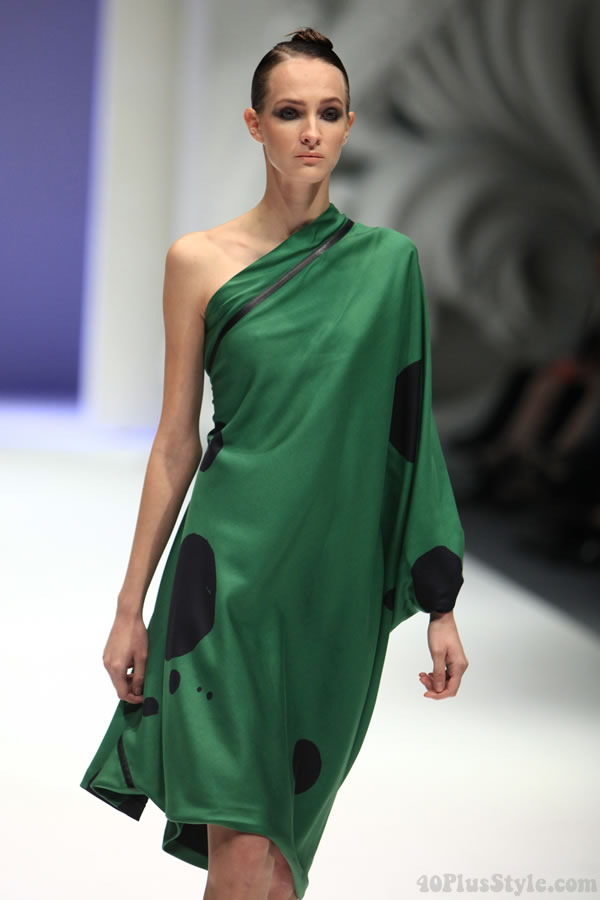
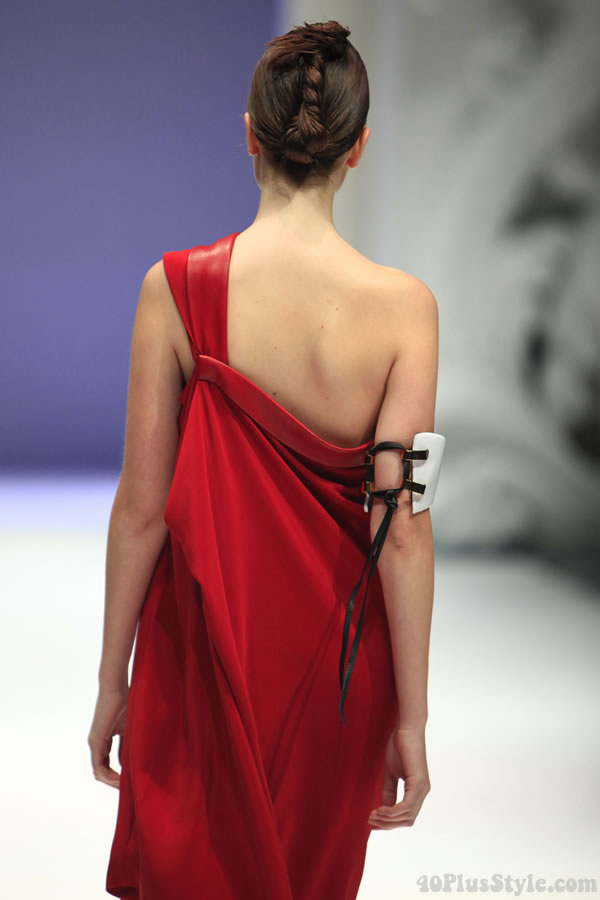

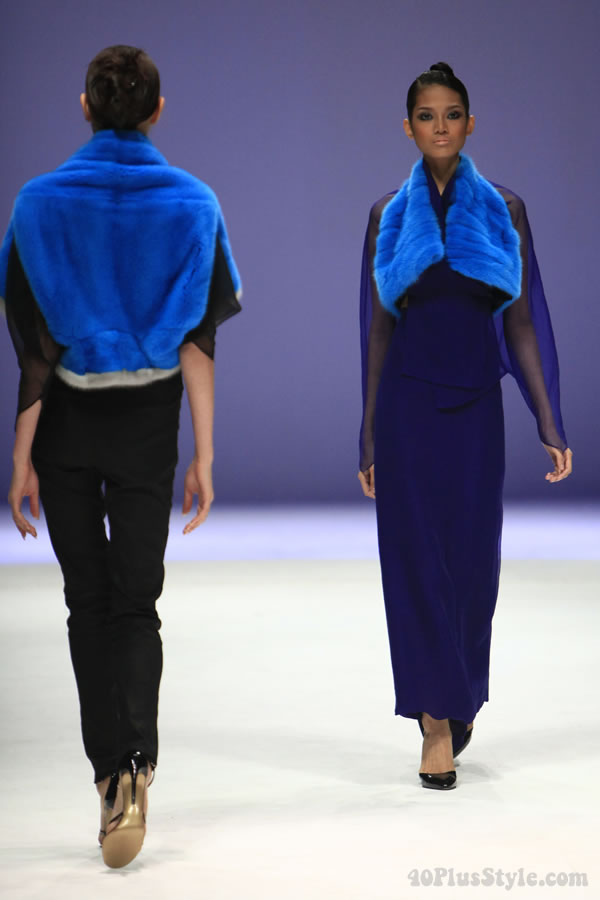

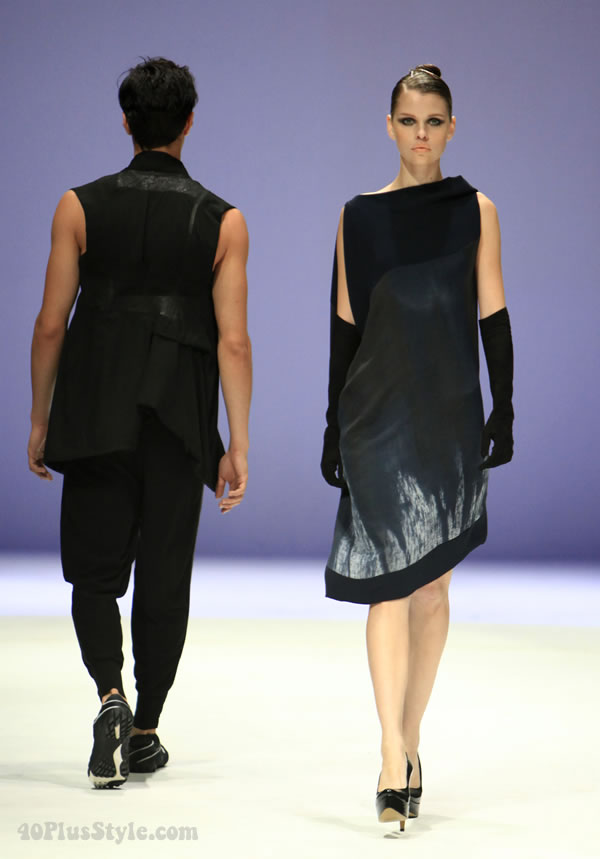
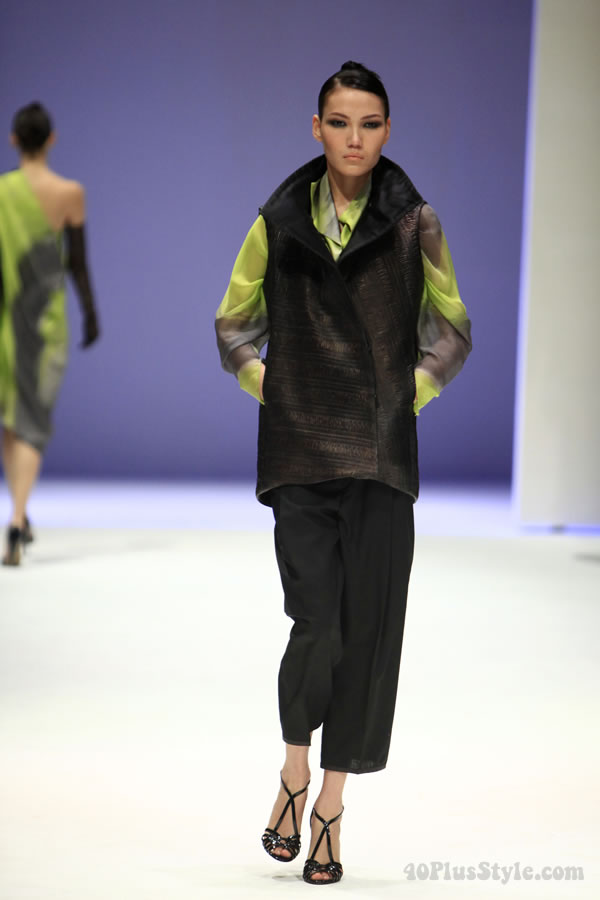
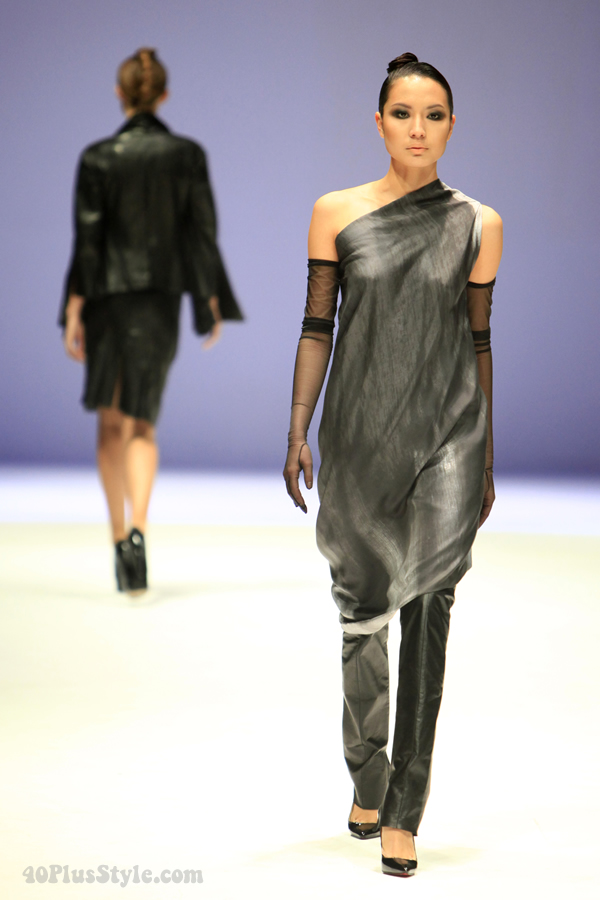
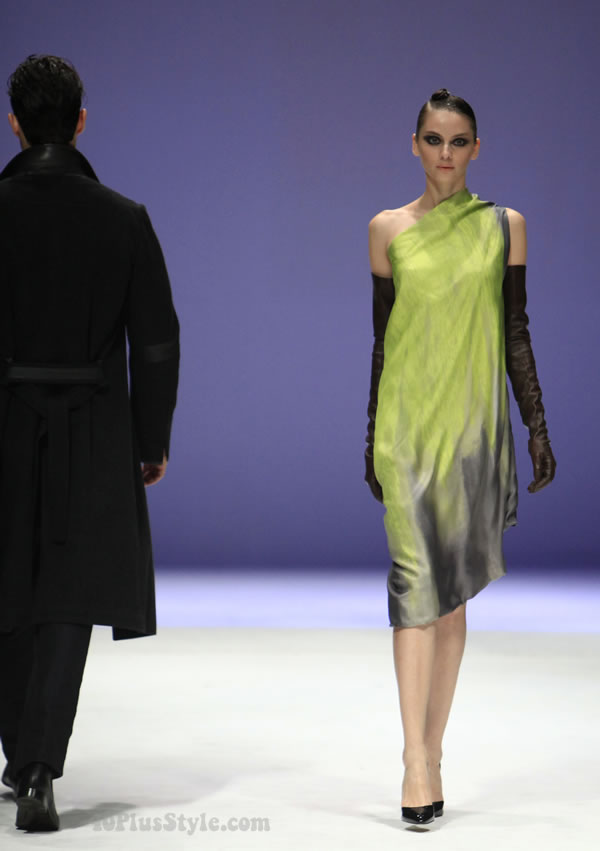


Your life is full of fun things! I like this designer who wants to design comfortable and wearable clothes for women. Hurray. I picked up a few ideas for combinations, looking at his designs. Like Susanne and Marianne, I think these clothes were made for you. No wonder he likes you do much. He recognizes this.
And I like a lot of them as well.
Most of the time it’s really quite boring, I can assure you! Great to hear that you got some new ideas Greetje!
I had another look and played the whole show (thank you for that). Really nice. Two little things I had not expect from him: those shoes were way too high and the slits were very high (and low) as well. But that black suit at the end of the show… To die for.
Like Suzanne I agree with her that this is your style [and mine], the drapes. The dresses look so simple and elegant because they just flow. But it takes a lot of skill to make them look this way. You would be the perfect model when he dicides to show with normal people . I also liked the menswear. My son would like them because they look so comfortable but still very stylish. Hope you can visit Paris.
It’s totally my style. Loved everything about the collection!
Very interesting interview. Love these kinds of posts. Those fashion shows must have been so much fun to attend.
They were a lot of fun indeed. I probably should have visited more… Glad you enjoyed this article. They take quite a bit of time to create so it’s good to hear that you and other readers enjoy them and get something out of them!
Great!! How nice he noticed your differentiated interviewing style, complimented and granted you with an invitation to visit his studio in Paris. Enjoy!
Hi Saskia. How lovely to hear from you! Perhaps we should go together to Paris next Summer?!
Hihi, before or after our yearly Amsterdam shopping tour? I’m getting to like the idea
This Interview is amazing! It is enlightening to learn how a designer gets his ideas and then the process for bringing those clothes to reality. Mr. Lins seems to respect women and wants to dress them in a flattering way. I love it that he said you would be his perfect model! The first thing I thought of when I looked at the pictures was that this is your style – the draping, minimalism, and even the colors are so you! I truly hope you get to make that trip to Paris!
Thanks Suzanne. I think he does too. It was great talking to him!